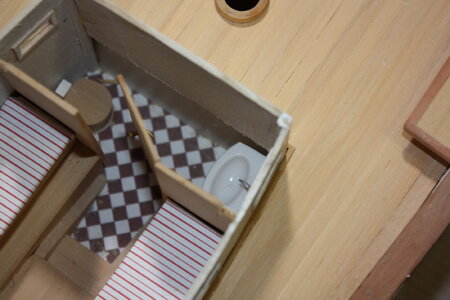So far, the conversation has been something along the lines of "should we criticize?" I'm not sure that's the right question to be asking. To my mind, at least, a better question is "how do we help the new modeler?" Those new to this craft (I really don't like the word "hobby") are the ones most likely to commit errors, and the ones most likely to commit serious errors. The difficulty is that many people do not know what they do not know. For example, when I built my first wooden model ship, I wanted it to be historically accurate, but to save myself some time, I bought a kit. Kit manufacturer's, I figured, would have put a lot of time and effort into researching their product. What could go wrong? Granted, I bought this kit when dinosaurs still roamed the earth, and that internet thing had yet to be invented, but I suspect the problem still exists today, at least to some extent. I also suspect that may new modelers don't know that kits are typically inaccurate.
The usual answer to this problem is to tell folks to do their research, but that's not a very specific instruction. There are several types of research that needs to be done:
(1) Research on your ship's history. I think, for whatever that's worth, that this is the least important part of building a model. but I would not be surprised to find that many new to ship modelling interpret the question this way.
(2) Research on what your ship looked like. This can be VERY involved. Part of this question involves learning whether the plans you have are accurate. If you're building something from the 17th century are earlier, its almost always the case that there were either no original drawn plans or, if there were, they have been lost. This is not something new modelers are likely to know. I wonder how many models of the Mayflower or the Santa Maria have been built by people who thought they were building exact replicas of these ships.
Part of this kind of work also involves finding and examining artwork. The latter is trickier than it sounds, at least with older ships. In the 17th century, at least, artists often made mistakes, and portrayed features that were never on any given ship. I wonder how widely this is known.
(3) Another part of the research is on how you are going to build your ship. This can involve researching shipbuilding techniques of the era you're interested in, and the woodworking techniques you need to know. This is also pretty involved.
IMHO, there is no good place for the new modeler to go to find this kind of information. Information for those new to the craft is often written by experienced modelers who know a lot, and forget how little someone who is new to the craft does not know.. It's not much of an overstatement to say that when I began, i was pretty sure that if you had deadeye, you should see an ophthalmologist, and that someone who was talking about a wale had made a grievous spelling error in their description of a marine mammal. How can we help the new modeler with research, when they do not know what they do not know?
Another difficulty is that information to ne modelers is usually found in a series of posts that contain material not always relevant to new folks. Having to wade through a series of posts can be frustrating. Books are also problematic. These "how to" books often describe how a modeler built a particular ship. The material in that book may not be relevant to a ship of a different period. This is not meant as a criticism of these books and posts. It is meant to illustrate how difficult it is for new modelers to find exactly the material they are looking for. So, again, "how do we help them?"
.
Then, too, there is the issue of outreach. It would not surprise me if we don't ever see most models. These are the models made by those who don't even know that there are modeling forums. I have no solution to this problem that doesn't cost a lot of advertising money, but it remains a problem. I only found SOS by accident, and there are probably a lot of people who have not had such a happy accident.











